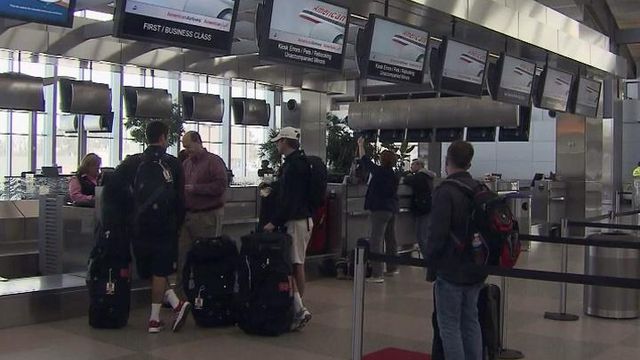American, US Airways announce $11 billion merger
American Airlines and US Airways say they have agreed to merge in an $11 billion deal to create the world's biggest airline.
Posted — UpdatedThe combined carrier will be called American Airlines but run by US Airways Chief Executive Doug Parker.
The boards of the two airlines unanimously approved the deal late Wednesday, and the companies announced the agreement Thursday.
The merger would reduce the number of major U.S. airlines to four: the new American, United, Delta and Southwest.
US Airways, a company with a strong legacy in North Carolina, employs about 32,000 people. Charlotte-Douglas International Airport is one of its four principal hubs, or what the airline calls "focus" cities. The other hubs are in Philadelphia, Phoenix, Ariz. and Washington, D.C.
The airline operates nearly 3,200 flights per day spread across 200 cities.
US Airways operates about 600 flights daily out of Charlotte. According to various media reports, Charlotte would be the second largest hub for the merged airline, ranking behind Dallas-Fort Worth, where American is based.
The two airlines have a combined 62 daily flights in and out of Raleigh-Durham International Airport, although the only overlap in their routes are flights to Reagan National Airport in Washington, D.C. Together, they will be RDU's largest carrier.
"What we have found (is), when cities don't overlap, we do not lose service," RDU spokeswoman Mindy Hamlin said. "This will be a process that will take at least 18 months, and that's when we'll know for sure how everything comes out."
Still, the merger has caused some uneasiness among area fliers.
"I said, 'Oh my, we're going to have less choices,'" Gina Holt said.
"I guess I have mixed feelings about it, so we don't really know what it means," said Roseanne Petes, who prefers flying American.
"I think it will probably mean higher prices since these airlines won't be competing," said her husband, Tom Petes.
Last year, ticket prices rose an average of 2 percent, but industry observers said the merger likely means passengers will pay more at the ticket counter and for services like checked baggage, early boarding or Wi-Fi.
"Long term, it's probably good because it makes the air transportation system more viable," analyst Eddie Albertson said.
Down the line, Albertson said there could be slight changes, such as how the airlines combine their frequent-flier programs.
"They will probably keep more of the structure of the American program. It was the first frequent-flier program in the industry and is the largest or close to largest in the world," he said.
American and US Airways also employ about 350 workers combined at RDU, but it's too early to tell how they might be affected,
Thursday's merger is the latest in a number over the years for US Airways. The latest came in 2005 when America West Holdings Corp., then led by Parker, agreed to merge with US Airways, which was in bankruptcy at the time.
Parker used $1.57 billion from backers, including planemaker Airbus, SAS and hedge fund Par Capital Management Inc. The deal was completed in September 2005.
Parker said in 2011 that he saw “one big deal left” after a hostile bid for Delta Air Lines Inc. collapsed in 2007 and two rounds of talks failed with former United Airlines parent UAL Corp.
The deal is a coup for smaller US Airways Group Inc., which pushed for a merger almost as soon as American parent AMR Corp. filed for bankruptcy protection in November 2011.
While Parker runs the company, AMR Chief Executive Tom Horton will serve as chairman until its first shareholder meeting, likely in mid-2014.
AMR interests, including creditors, will own 72 percent of the new company and US Airways shareholders 28 percent.
The companies said merging would create savings of more than $1 billion a year. The merger will be part of AMR's plan for exiting bankruptcy protection.
The airlines said they expect $1 billion in combined savings.
The companies had negotiated since August, when creditors pushed AMR to conduct merger talks so they could decide which earned them a better return: a merger or an independent American.
The deal would need approval by AMR's bankruptcy judge and antitrust regulators, who have permitted three other big airline mergers to go ahead since 2008.
The rapid consolidation has allowed the surviving airlines to offer bigger route networks that appeal to high-paying business travelers, and it has allowed them to limit the supply of seats, which helps prop up fares and airline profits.
The new American would have more than 900 planes, 3,200 daily flights and about 95,000 employees, not counting regional affiliates. It will be slightly bigger than United Airlines by passenger traffic, not counting regional affiliate airlines.
• Credits
Copyright 2024 by WRAL.com and the Associated Press. All rights reserved. This material may not be published, broadcast, rewritten or redistributed.





